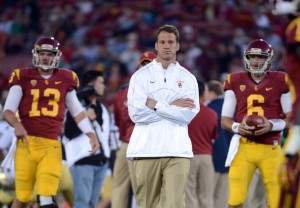But let’s puts everything aside — Kiffin for being Kiffin, the fact that USC had 1st and goal from the Notre Dame 2 with over 5 minutes remaining and then proceeded to waste over 150 seconds of clock — and look at one particular decision. Facing 4th and goal from the Notre Dame 1-yard line, trailing by 9 points with 2:33 left, Kiffin decided to go for it.
This clearly defies conventional wisdom, and when the move failed, it opened him up to even more criticism. But was it the right call? According to Brian Burke, if this had been an NFL game, the correct call would have been to kick the field goal.
That may not surprise traditionalists, but readers of this blog and Advanced NFL Stats may be surprised to find that, according to the 4th Down Calculator, when trailing by 9 with 2:33 remaining, you need an 87% chance of converting to make going for it the correct call. (I will note that if you are trailing by 10, things change dramatically and going for it is the correct play.)
But this was not an NFL game. Burke’s model is based on two assumptions that are relevant here: one, the team has an average number of timeouts remaining, and two, that the clock will stop with 2:00 to go. USC had one timeout left (which is probably below average for this situation) and there is no two-minute warning in college football. So it’s likely that using 2:33 is not the correct number to use the 4th down calculator for college.
If you use 2:33 remaining, you need an 87% chance of converting to make going for it the correct call.
But, according to the same model, if you use 2:03, it drops to 64%.
If you use 1:33, it drops to 13%.
Obviously figuring out which input to use is very important. However, let’s think about it in a different context.
If USC scores a touchdown and does not onside kick (which I don’t think they do), ND gets the ball at roughly the 25-yard line with 2:25 left. On 1st and 10, they run, USC calls timeout, and there is 2:20 left. On second down, Notre Dame runs, 40 seconds tick off, and there is 1:35 left. Rinse, repeat, and Notre Dame punts with 50 seconds left. This means USC gets the ball with roughly 40 seconds left at say, their own 45.
Here college football’s rules benefit the Trojans because the clock stops momentarily on first downs. At this point, it comes down to this:
1) What are USC’s odds of scoring a touchdown with no timeouts and 55 yards away with 40 seconds left? Call this T.
2) What are USC’s odds of scoring a field goal with no timeouts and 55 yards from the other team’s end zone with 40 seconds remaining? Call this F.
Let’s assume, conservatively, that USC has a 50% chance of scoring a touchdown from the 1 (in the NFL the conversion rate would be 68%, but Notre Dame’s run defense is excellent. In reality, USC called a good play but poorly executed the pass.) and that USC has a 100% chance of success if they kick the field goal from the 1.
In that case, the only remaining question is whether F is twice as large as T or not. My guess is yes — it’s significantly easier to drive for a field goal than to score a touchdown. And if you think USC has a greater than 50% chance of scoring a touchdown from the 1, then F can be even lower.
No hard math here, just my gut. And let’s not forget that if you fail from the 1, you have at least a chance of forcing a safety and getting the ball back with a chance to tie. The odds aren’t great, but that possibility does enter the calculus. Lane Kiffin is not a good coach and he’s made a zillion mistakes. This might have been one of them — I don’t have a definitive answer either way — but my opinion is he made the correct call. Scoring a touchdown from 55 yards away with only 40 seconds left is really, really hard. The difference between that and scoring a field goal in that situation has to be larger than the difference between the two scoring options from the one-yard-line.

